
Alternative Funding

Access a suite of non-conventional mortgage solutions—government-backed FHA/VA/USDA loans, jumbo and portfolio financing, interest-only and balloon mortgages, bridge and hard-money loans, reverse mortgages, HELOCs, 203(k) renovation loans, construction loans, DSCR loans, and private financing—to suit diverse borrower profiles. EstateGather’s Alternative Funding guide delivers key takeaways, side-by-side feature comparisons, and strategic insights to help you choose the right financing for your real estate objectives.
Alternative Funding
Non-conventional loans, also known as non-traditional mortgages, offer alternative financing options for borrowers who may not qualify for conventional loans, or who have unique financial needs. These loans are often insured or guaranteed by government agencies such as the Federal Housing Administration (FHA), the Department of Veterans Affairs (VA), or the U.S. Department of Agriculture (USDA), making them accessible to a wider range of borrowers. Non-conventional loans can also include other flexible financing options provided by private lenders. They cater to various borrower profiles, including those with lower credit scores, limited down payments, or special property requirements. There are several different types of non-conventional loans, including:
KEY TAKEAWAYS
- Flexibility in Qualification: Non-conventional loans offer flexible qualification criteria, making them accessible to borrowers with lower credit scores, limited down payments, or unique financial situations.
- Government-Backed Options: Loans like FHA, VA, and USDA are backed by government agencies, providing lower interest rates, reduced down payments, and favorable terms for eligible borrowers.
- Specialized Loans: Options such as jumbo loans, hard money loans, and 203(k) loans cater to specific needs, including high-value property purchases, short-term real estate investments, and property renovations.
- Diverse Funding Sources: Non-conventional loans can be sourced from private lenders, offering customized terms and quicker approval processes, particularly useful for time-sensitive investments.
- Risk and Cost Considerations: While offering greater access, non-conventional loans often come with higher interest rates and fees, reflecting the increased risk to lenders and the specialized nature of the financing.
Conventional Loans include both Conforming and Non-Conforming Loans. Below is a comparison of the two loan types.
| Feature | Conforming Loans | Non-Conforming |
|---|---|---|
| Loan Limits | Set by FHFA | ✅ Can exceed FHFA limits |
| Interest Rates | ✅ Lower interest rates | Higher rates due to risk for lenders |
| Down-Payment | ✅ Low down payment options | Larger down-payments |
| Documentation | ✅ Standard income and assets check | More extensive |
| Approval Process | Specific guidelines | ✅ More flexible |
| Eligibility | ✅ Easier to qualify | Excellent credit and income |
| Availability | ✅ Common | Limited |
| Secondary Market | ✅ Fannie Mae and Freddie Mac | Typically not purchased |
What is a Conforming Loan?
A conforming loan is a mortgage that meets the guidelines set by Fannie Mae and Freddie Mac, the government-sponsored enterprises that purchase mortgages. These guidelines typically include limits on loan size, borrower creditworthiness, and debt-to-income ratios. Conforming loans often offer lower interest rates than non-conforming loans because they are considered less risky and easier to sell on the secondary market.
What are Fannie Mae and Freddie Mac?
Fannie Mae and Freddie Mac are government-sponsored enterprises (GSEs) in the U.S. that help support the housing market by buying mortgages from lenders, pooling them into mortgage-backed securities (MBS), and selling these securities to investors. Their role increases the availability of funds for home loans, making it easier for borrowers to get mortgages.
- Fannie Mae (Federal National Mortgage Association): Focuses on buying mortgages from large commercial banks.
- Freddie Mac (Federal Home Loan Mortgage Corporation): Primarily buys mortgages from smaller banks and credit unions.
Both aim to promote liquidity, stability, and affordability in the housing market, but they are privately owned and operate under a federal charter.
What is the FHFA?
The Federal Housing Finance Agency (FHFA) is a U.S. government agency that oversees and regulates the mortgage giants Fannie Mae and Freddie Mac, as well as the Federal Home Loan Bank System. Its primary responsibilities include ensuring these entities operate safely, fostering a stable housing finance system, and setting annual conforming loan limits that determine the maximum size of loans eligible for purchase by Fannie Mae and Freddie Mac.
Sponsor
YOUR
ADVERTISEMENT
HERE
Just $20 a Month, for full site coverage.

Government Loan Options
U.S. government loan programs are designed to make homeownership and real estate investment more accessible. These loans, which include FHA, VA, and USDA loans, offer lower down payments, competitive interest rates, and flexible credit requirements. You can read our whole article dedicated to Government Loans, here.
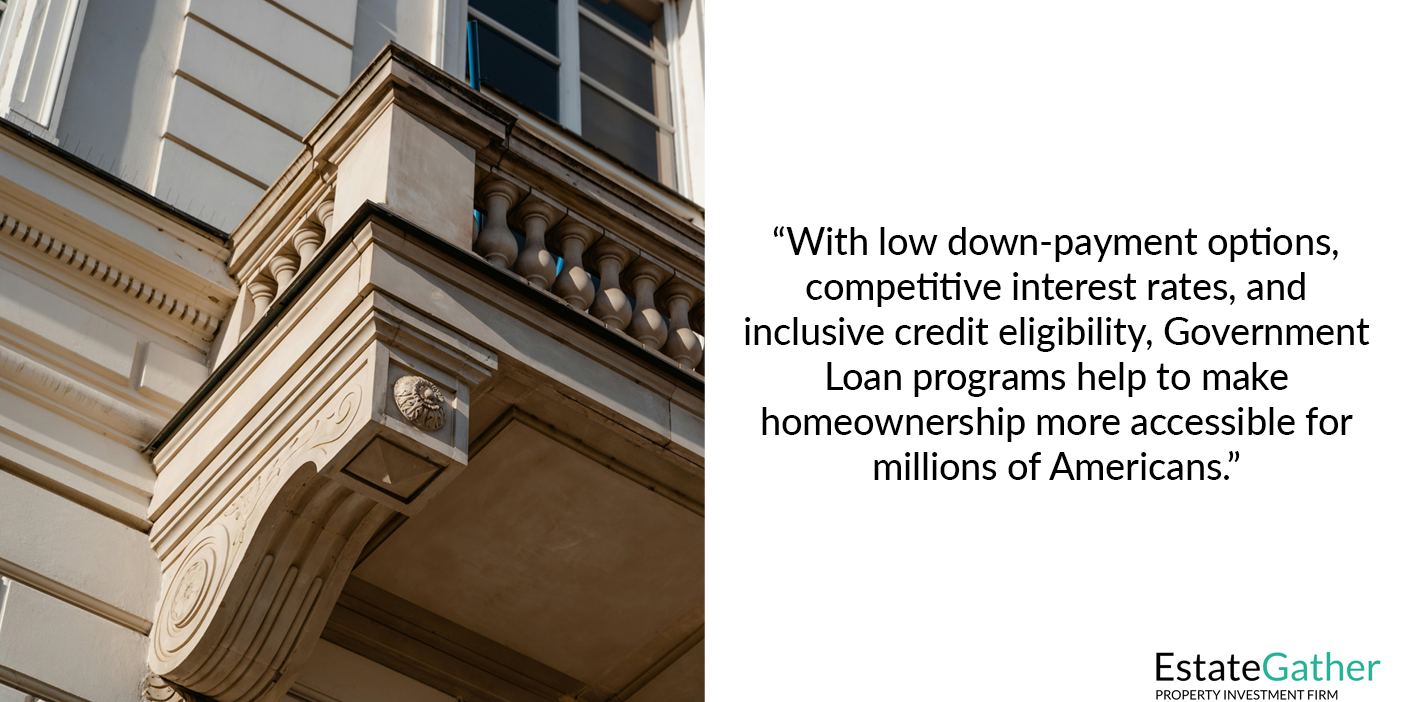
Federal Housing Administration (FHA) loans require as little as a 3.5% down payment, feature inclusive credit eligibility criteria, and offer competitive interest rates, making them accessible to a wide range of borrower profiles. However, they also require mortgage insurance premiums, must meet specific property standards, have varying loan limits by location, and mandate that the property be owner-occupied for at least one year.
Veterans Affairs (VA) loans are notable for requiring no down payment, providing competitive interest rates, not needing private mortgage insurance, and offering flexible credit requirements. These loans are exclusively available to eligible veterans, service members, and specific National Guard and Reserves members. The property must be owner-occupied for one year, and there are funding fees associated with these loans.
United States Department of Agriculture (USDA) loans similarly require no down payment and offer favorable interest rates. They are accessible to low- to moderate-income borrowers and are designed for properties in rural and designated suburban areas. However, USDA loans come with property location restrictions, income limits, property condition standards, and an owner-occupancy requirement for at least one year. Additionally, there are USDA funding fees and annual fees to consider.
Compared to other non-conforming loans, government loans generally offer lower interest rates and lower down payment options. They involve standard income and asset checks with flexible approval processes, making them easier to qualify for and more commonly available through agencies like Ginnie Mae. In contrast, other non-conforming loans often have higher requirements and are less accessible.
Jumbo Loans
Non-conventional jumbo loans are a subset of jumbo loans that do not conform to the conventional lending standards set by Fannie Mae and Freddie Mac. These loans cater to borrowers who might not meet the stringent criteria of conventional jumbo loans, such as high credit scores, substantial down payments, or low debt-to-income ratios. Non-conventional jumbo loans offer flexibility in terms of loan approval and are tailored for unique financial situations.
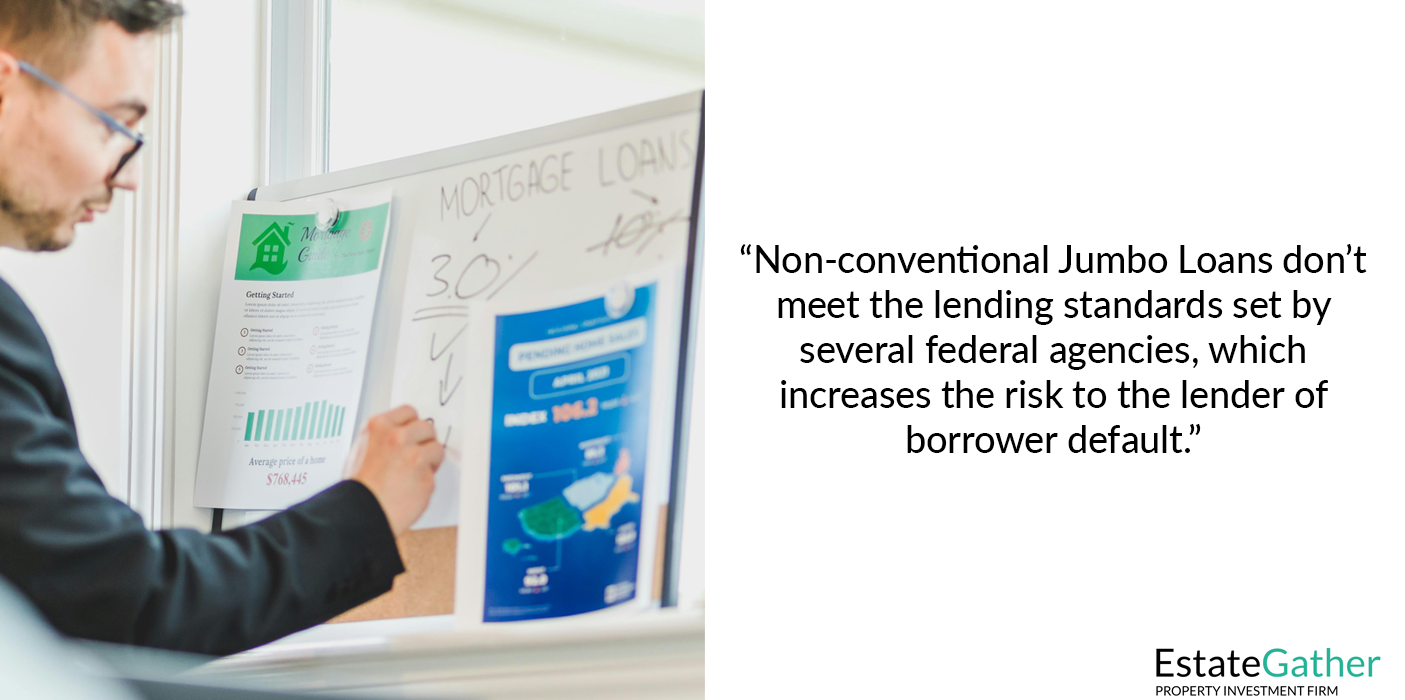
Non-conventional jumbo loans have more lenient qualification requirements compared to their conventional counterparts. They are designed to accommodate borrowers with diverse financial backgrounds, including those with lower credit scores, higher debt-to-income ratios, or unconventional income sources. This flexibility makes them accessible to a wider range of borrowers.
These loans still exceed the conforming loan limits set by the Federal Housing Finance Agency (FHFA), but they offer more customization in loan amounts to fit the specific needs of the borrower. These loans are ideal for financing unique, high-value properties that do not fit within the constraints of conventional loan limits.
Due to the increased risk associated with non-conventional jumbo loans, lenders typically charge higher interest rates and fees compared to conventional jumbo loans. Borrowers should be prepared for these additional costs, which can vary depending on the lender and the borrower’s financial profile.
While conventional jumbo loans often require a minimum down payment of 20%, non-conventional jumbo loans may offer more flexible down payment options. Some lenders might accept lower down payments, though this could result in higher interest rates or the need for private mortgage insurance (PMI).
Non-conventional jumbo loans provide a variety of loan terms, including adjustable-rate mortgages (ARMs) and fixed-rate mortgages (FRMs). Borrowers can choose the loan term that best suits their financial situation and long-term goals, whether they prefer the stability of a fixed rate or the initial lower payments of an adjustable rate.
Given their non-conforming nature, non-conventional jumbo loans may require specialized documentation to verify the borrower’s financial status. This could include alternative forms of income verification, such as bank statements or asset-based documentation, instead of traditional income proof like W-2s or tax returns.
These loans are particularly useful for financing properties that fall outside the norm, such as vacation homes, investment properties, or unique residential properties. Non-conventional jumbo loans provide the financial means to purchase these distinctive properties.
The availability of non-conventional jumbo loans can vary significantly based on market conditions and the lender’s policies. During economic downturns or periods of market instability, lenders may tighten their lending criteria for these loans. Conversely, during stable economic times, more lenders may offer flexible options for non-conventional jumbo loans.
Sponsor
YOUR
ADVERTISEMENT
HERE
Just $20 a Month, for full site coverage.

Portfolio Loans
Portfolio loans are a type of mortgage that a lender issues and retains in their own investment portfolio rather than selling on the secondary market. This retention allows lenders to establish more flexible underwriting criteria and terms compared to conventional loans, making portfolio loans an appealing option for borrowers who might not qualify for traditional financing. These loans offer lenders the flexibility to establish their own underwriting standards, enabling borrowers with unique financial situations, such as lower credit scores, higher debt-to-income ratios, or irregular income streams, to still qualify for a mortgage. Lenders can consider the overall financial picture of the borrower rather than adhering strictly to conventional guidelines.

Due to portfolio loans being kept in-house, lenders can offer a variety of loan terms tailored to the needs of the borrower, including adjustable-rate mortgages (ARMs), fixed-rate mortgages (FRMs), and hybrid options. Borrowers can work directly with the lender to find terms that best fit their financial goals and circumstances. Additionally, by eliminating the need to meet secondary market requirements, portfolio loans can sometimes come with lower origination and processing fees, making them an attractive option for borrowers looking to minimize upfront expenses.
Because lenders retain portfolio loans in their own investment portfolios, they have a vested interest in the performance of these loans, often resulting in more personalized customer service and greater flexibility in handling any issues that may arise during the loan’s life. Borrowers may find it easier to work with the lender on modifications or refinancing if their financial situation changes. Portfolio loans are particularly beneficial for financing unique or non-conforming properties that might not meet the criteria for conventional loans, such as investment properties, mixed-use properties, and homes with unconventional structures or zoning issues. Lenders have the discretion to approve loans for these types of properties based on their own risk assessments.
While portfolio loans offer flexibility and customization, they may come with higher interest rates compared to conventional loans due to the increased risk that lenders assume by keeping these loans in their portfolios. However, interest rates can vary widely depending on the borrower’s financial profile and the specifics of the loan agreement. The availability of portfolio loans can vary based on the lender and market conditions. Not all lenders offer portfolio loans, and those that do may have different criteria and terms. Borrowers interested in portfolio loans should seek out lenders that specialize in this type of financing and discuss their specific needs and qualifications.
Interest-Only Loans
Interest-only loans are a type of mortgage where the borrower is required to pay only the interest on the loan for a specific period, usually between five and ten years. After this interest-only period ends, the borrower must begin repaying both the principal and the interest, often resulting in significantly higher monthly payments. These loans can be attractive to certain borrowers due to their lower initial payments, but they also come with potential risks.
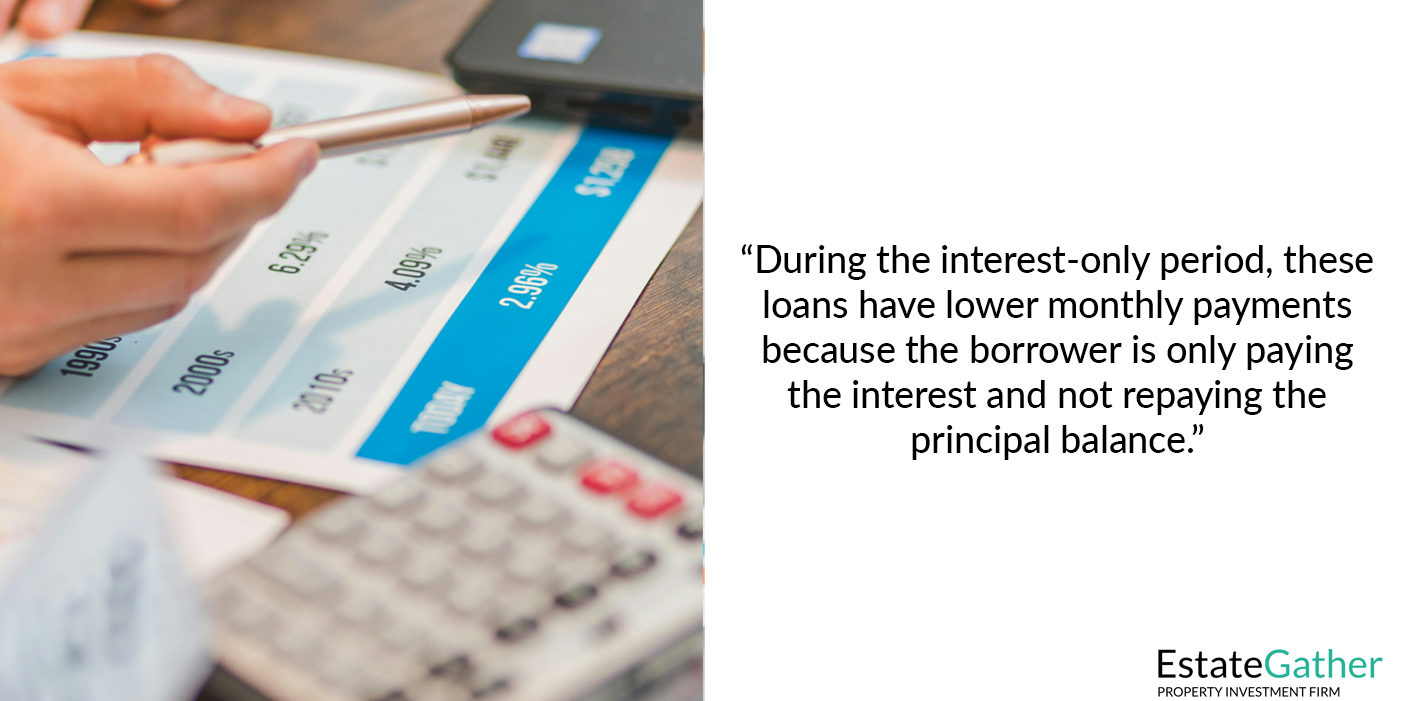
One of the main advantages of interest-only loans is the lower initial monthly payments. During the interest-only period, borrowers only pay the interest on the loan, which can make homeownership more affordable in the short term. This can be particularly beneficial for borrowers who anticipate an increase in their income or those who prefer to allocate their funds to other investments initially. However, after the interest-only period ends, borrowers must start paying both the principal and the interest, which can lead to a significant increase in monthly payments. It is important for borrowers to plan ahead and ensure they will be able to afford these higher payments when the time comes.
Interest-only loans can provide borrowers with flexibility in managing their finances. The lower initial payments can free up cash flow for other purposes, such as investing, paying off other debts, or funding major expenses. This can be particularly advantageous for borrowers with fluctuating incomes or those who receive large bonuses or commissions. Despite these benefits, interest-only loans come with several risks that borrowers should consider. If property values decline, borrowers may find themselves owing more than the home is worth, a situation known as being “underwater.” Additionally, if the borrower’s financial situation does not improve as anticipated, the higher payments after the interest-only period can become unmanageable.
Interest-only loans are typically best suited for borrowers who have a clear strategy for managing the higher payments after the interest-only period ends. This can include individuals who expect a substantial increase in their income, those who plan to sell the property before the interest-only period ends, or those who have other investments that will mature and provide the necessary funds. The availability of interest-only loans can vary based on market conditions and lender policies. These loans were more common before the financial crisis of 2008, but they have become less prevalent as lenders have tightened their lending criteria. Borrowers interested in interest-only loans should seek out lenders who offer these products and carefully review the terms and conditions.
Interest rates on interest-only loans can be either fixed or adjustable. Adjustable-rate interest-only loans may start with lower interest rates, but they carry the risk of increasing rates over time. Borrowers should consider the potential impact of rising interest rates on their future payments. Overall, interest-only loans can be a valuable tool for certain borrowers, but it is essential to understand the risks and plan accordingly for the higher payments that will come once the interest-only period concludes. Try different interest rates using this calculator to see how the monthly payments are changed in a fully amortizing, fix rate loan.
Check out our Amortization Calculator for a more capable analysis tool.
Interest Rates & Payments

Sponsor
YOUR
ADVERTISEMENT
HERE
Just $20 a Month, for full site coverage.

Balloon Loans
Balloon loans are a type of mortgage that features relatively low monthly payments for a set period, followed by a large “balloon” payment of the remaining balance at the end of the loan term. This structure can make monthly payments more manageable initially, but borrowers must be prepared for the substantial final payment. Typically, balloon loans have shorter terms than traditional mortgages, often ranging from 5 to 7 years. During the loan term, borrowers make monthly payments that cover interest and a small portion of the principal, or sometimes just the interest. At the end of the term, the remaining principal balance is due in full as a lump sum.
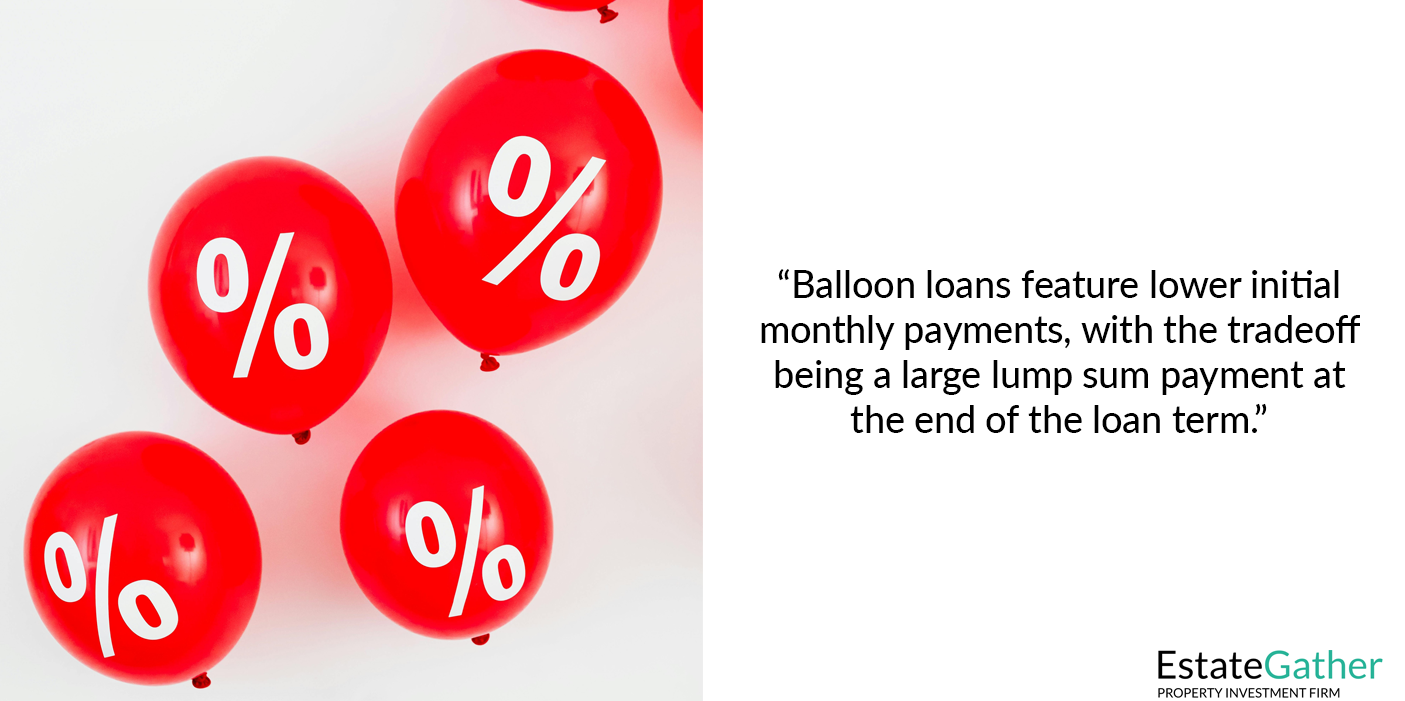
One of the main advantages of balloon loans is the lower initial monthly payments, which can be appealing to borrowers who anticipate an increase in income, expect to refinance, or plan to sell the property before the balloon payment is due. This can provide financial flexibility and allow borrowers to manage their cash flow more effectively in the short term. However, balloon loans come with significant risks. The most notable is the large final payment. Borrowers must have a clear plan for how they will handle this balloon payment, whether through savings, refinancing, or selling the property. If a borrower is unable to make the final payment, they risk defaulting on the loan, which can lead to foreclosure.
These loans are best suited for borrowers with strong financial planning skills and a clear strategy for managing the balloon payment. They can be useful for those who have a solid plan for increasing their income, anticipate substantial financial gains, or are confident in their ability to refinance the loan before the balloon payment is due. Balloon loans can also be attractive for certain types of real estate investments. Investors who purchase properties with the intention of selling them within a few years may benefit from the lower monthly payments, as long as they are prepared for the large payment at the end.
The availability and terms of balloon loans can vary significantly based on market conditions and lender policies. Not all lenders offer balloon loans, and those that do may have specific criteria for borrowers. It is important for potential borrowers to thoroughly understand the terms and risks associated with balloon loans and to ensure they have a solid plan for the end of the loan term. Overall, balloon loans can be a valuable tool for certain borrowers, but they require careful consideration and financial planning to manage the risks effectively.
Bridge Loans
Bridge loans are short-term financing solutions designed to “bridge” the gap between the purchase of a new property and the sale of an existing one. These loans provide immediate funds that allow borrowers to close on a new property before selling their current home. Bridge loans are particularly useful for homeowners who need to buy a new home quickly or who want to take advantage of an opportunity without waiting for their existing home to sell.
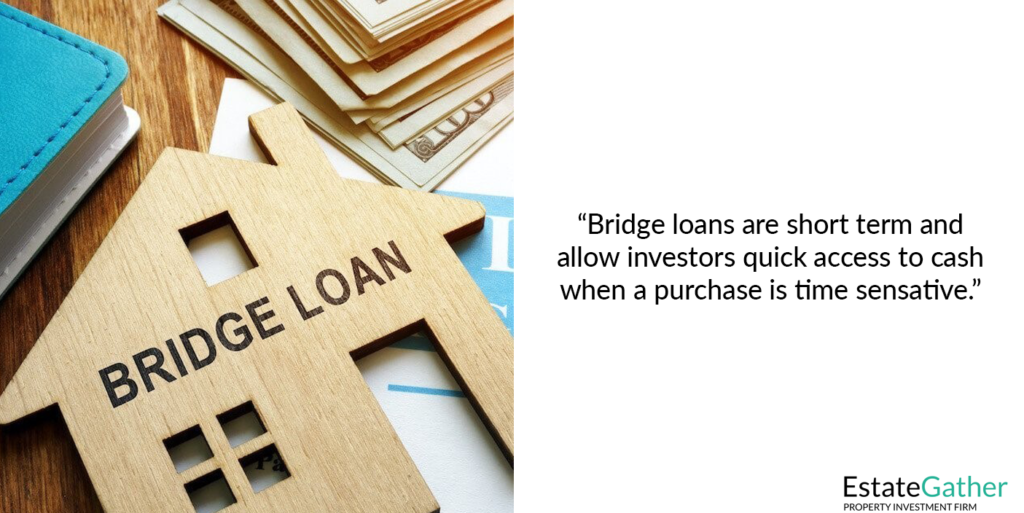
Bridge loans typically have terms ranging from six months to a year, though some can extend up to three years. The primary advantage of a bridge loan is the ability to access funds quickly. This can be crucial in competitive real estate markets where timing is essential. By securing a bridge loan, borrowers can make a down payment on a new home or cover other purchasing costs, ensuring they do not miss out on desirable properties due to timing constraints.
However, bridge loans come with higher interest rates compared to traditional mortgages, reflecting the short-term nature and increased risk for lenders. Additionally, these loans often involve substantial fees and closing costs, which can add to the overall expense. Borrowers must also be aware that if their current home does not sell within the loan term, they could face financial strain, as they would need to repay the bridge loan without the anticipated proceeds from the sale.
Bridge loans are best suited for borrowers who have a strong financial profile and a high level of confidence that their current home will sell quickly. These loans are commonly used by real estate investors, homeowners looking to upgrade or downsize, and individuals who need to relocate for work and cannot afford a lengthy selling process.
The application process for a bridge loan can be quicker than that for a traditional mortgage, but it still requires a thorough review of the borrower’s financial situation, including credit scores, income verification, and an assessment of the value of both the existing and new properties. Lenders may require the borrower to have significant equity in their current home to qualify for a bridge loan.
While bridge loans offer significant benefits in terms of flexibility and speed, they also carry risks. Borrowers should carefully consider their ability to manage the higher interest rates and potential financial burdens if their current home does not sell as quickly as anticipated. Consulting with a financial advisor or mortgage professional can help borrowers evaluate whether a bridge loan is the best option for their specific circumstances and financial goals.
Overall, bridge loans can be an effective tool for facilitating property transactions, provided that borrowers are well-prepared and understand the associated costs and risks.
Sponsor
YOUR
ADVERTISEMENT
HERE
Just $20 a Month, for full site coverage.

Hard Money Loans
Hard money loans are a type of asset-based financing used in real estate transactions. Unlike traditional loans, which are primarily based on the borrower’s creditworthiness and income, hard money loans are secured by the value of the property being purchased or used as collateral. This makes them an attractive option for borrowers who may not qualify for conventional loans or need funds quickly for time-sensitive investments.
Hard money loans are typically provided by private investors or companies rather than traditional banks or credit unions. These lenders are more concerned with the value and potential of the property than the borrower’s credit history or financial situation. As a result, the approval process for hard money loans is often faster and less stringent, allowing borrowers to access funds quickly, sometimes within days.

One of the primary advantages of hard money loans is their speed and flexibility. Because these loans are based on the collateral’s value, they can be processed and approved much faster than conventional loans. This quick turnaround is particularly beneficial for real estate investors looking to capitalize on immediate opportunities, such as property flips or auctions, where timing is crucial.
However, hard money loans come with higher interest rates and fees compared to traditional financing options, reflecting the increased risk taken on by the lender. Additionally, borrowers may face higher origination fees, which can add to the overall cost of the loan. These higher costs are the trade-off for the flexibility and speed of access to funds.
Hard money loans are generally short-term, with terms ranging from six months to a few years. This makes them suitable for projects that anticipate a quick turnaround, such as renovations and flips. Borrowers are expected to either repay the loan through the sale of the property, refinancing, or by securing long-term financing once the project’s value has increased. However, some Hard money loans are for much longer periods of time, and could even be thirty year, fully amortizing loans.
The underwriting criteria for hard money focuses heavily on the loan-to-value (LTV) ratio, which is the loan amount divided by the value of the property. Lenders typically offer loans with LTV ratios between 60% and 75%, ensuring that they have a significant equity cushion to mitigate their risk. Borrowers may also need to provide a down payment or additional collateral to secure the loan.
Despite their advantages, hard money loans carry significant risks for borrowers. The high-interest rates and short repayment terms mean that borrowers must have a clear and viable plan for repaying the loan. Failure to repay can result in the loss of the property used as collateral. Additionally, the higher costs can eat into the potential profits of a real estate investment, so careful financial planning and risk assessment are essential.
Hard money loans are best suited for experienced real estate investors who understand the market and have a solid strategy for their investment projects. They are also useful for borrowers who may not meet the strict criteria of traditional lenders but have valuable assets to leverage.
Reverse Mortgages
Reverse mortgages are a unique financial product designed for homeowners aged 62 and older, allowing them to convert a portion of their home equity into cash. Unlike traditional mortgages, where borrowers make monthly payments to the lender, a reverse mortgage provides payments to the homeowner, offering a way to supplement retirement income, cover healthcare expenses, or finance home improvements.

The most common type of reverse mortgage is the Home Equity Conversion Mortgage (HECM), which is insured by the Federal Housing Administration (FHA). To qualify for a reverse mortgage, homeowners must own their home outright or have a significant amount of equity, live in the home as their primary residence, and meet other eligibility criteria set by the FHA.
One of the primary advantages of a reverse mortgage is that it allows seniors to access the equity in their home without having to sell it or take on monthly mortgage payments. The loan proceeds can be received in various ways, including a lump sum, monthly payments, a line of credit, or a combination of these options. This flexibility makes reverse mortgages a valuable tool for managing cash flow in retirement.
Reverse mortgages do not require monthly mortgage payments. Instead, the loan is repaid when the borrower sells the home, moves out permanently, or passes away. The amount owed on a reverse mortgage increases over time as interest and fees accumulate. However, the borrower or their heirs will never owe more than the home’s value when it is sold, even if the loan balance exceeds the home’s market value, thanks to the FHA insurance.
While reverse mortgages can provide financial relief and flexibility, they also come with costs and risks. The fees associated with reverse mortgages can be higher than those of traditional mortgages, including origination fees, mortgage insurance premiums, and closing costs. Additionally, interest on the loan accrues over time, increasing the total amount that must be repaid.
It is also important for borrowers to understand that they remain responsible for property taxes, homeowners insurance, and maintenance of the home. Failure to meet these obligations can lead to foreclosure. Moreover, using a reverse mortgage reduces the amount of equity left in the home, which can affect the inheritance left to heirs.
Reverse mortgages are best suited for seniors who plan to stay in their home for a long time, need additional income, and have no plans to leave the property to heirs or are comfortable leaving less equity. It is crucial for potential borrowers to thoroughly understand the terms and implications of a reverse mortgage and to consider their long-term financial needs and goals.
Before taking out a reverse mortgage, homeowners are required to meet with a HUD-approved housing counselor. This counseling session ensures that borrowers fully understand the costs, benefits, and potential alternatives to a reverse mortgage, helping them make an informed decision.
Sponsor
YOUR
ADVERTISEMENT
HERE
Just $20 a Month, for full site coverage.

Home Equity Lines of Credit (HELOCs)
A Home Equity Line of Credit (HELOC) is a flexible, revolving line of credit secured by the equity in a borrower’s home. This financial product allows homeowners to borrow funds as needed, up to a predetermined credit limit, and is often used for home improvements, debt consolidation, education expenses, or other significant financial needs.
A HELOC functions similarly to a credit card, where borrowers have access to a set amount of money and can draw from it as needed over a specific period, known as the draw period. The draw period typically lasts 5 to 10 years. During this time, borrowers are usually required to make interest-only payments on the amount they have borrowed. Once the draw period ends, the repayment period begins, typically lasting 10 to 20 years, during which the borrower must repay both the principal and the interest.
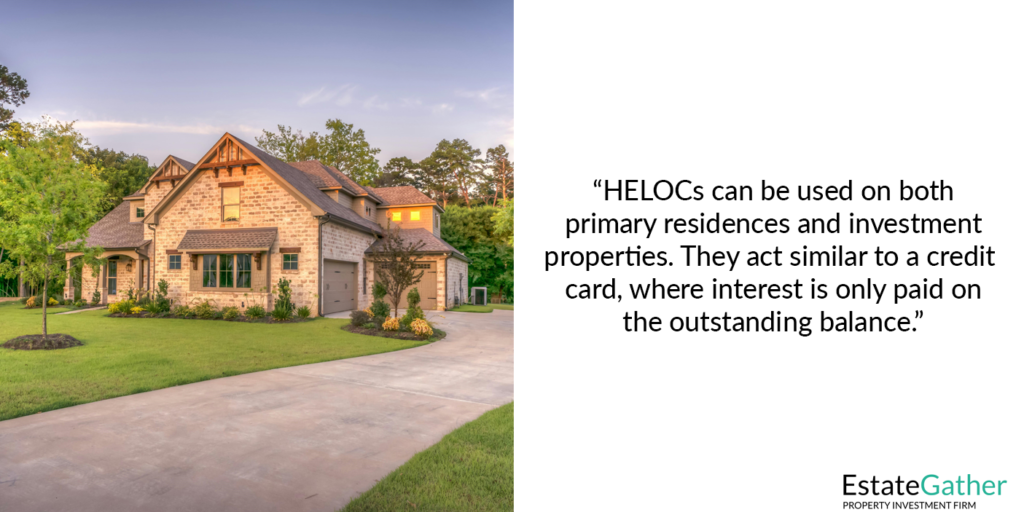
One of the primary advantages of a HELOC is its flexibility. Borrowers can access funds as needed, making it an ideal solution for expenses that are spread out over time, such as ongoing home renovations or tuition payments. The interest rates on HELOCs are typically variable, meaning they can change over time based on market conditions. This can result in lower initial interest rates compared to fixed-rate loans, though it also means the monthly payments can fluctuate.
Another benefit of HELOCs is that interest paid on the borrowed funds may be tax-deductible, provided the loan is used for home improvements and meets the IRS requirements. This potential tax advantage can make HELOCs a cost-effective borrowing option for qualifying homeowners.
However, there are risks and considerations associated with HELOCs. The variable interest rates mean that monthly payments can increase if market interest rates rise, potentially leading to higher overall borrowing costs. Additionally, because a HELOC is secured by the home, failure to make payments can result in foreclosure, putting the borrower’s home at risk.
Borrowers must also be mindful of the temptation to use a HELOC for discretionary spending, which can lead to increased debt and financial strain. It is important to use the funds wisely and have a clear repayment plan in place.
To qualify for a HELOC, lenders typically require a substantial amount of home equity, usually at least 15% to 20% of the home’s value, a good credit score, and a stable income. The application process involves a thorough review of the borrower’s financial situation, including income verification, credit history, and an appraisal of the home’s value.
203(k) Loans
The 203(k) loan, offered by the Federal Housing Administration (FHA), is a type of mortgage that allows borrowers to finance both the purchase of a home and the necessary repairs or renovations in a single loan. This loan is designed to help homeowners and homebuyers make improvements to their properties, thereby increasing the home’s value and enhancing the community.
The primary advantage of a 203(k) loan is that it combines the cost of the home and the renovation expenses into a single mortgage, simplifying the financing process. This can be particularly beneficial for buyers who are purchasing homes that need significant repairs, as it eliminates the need to secure separate financing for the home purchase and the renovations.
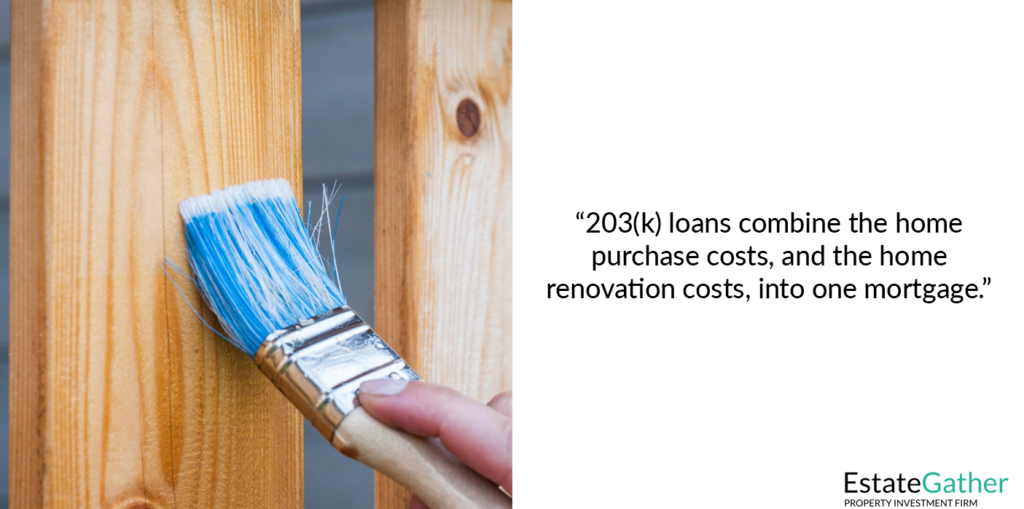
There are two main types of 203(k) loans: the Standard 203(k) and the Limited 203(k). The Standard 203(k) loan is intended for more extensive renovations and requires a minimum of $5,000 in repairs. It can cover a wide range of improvements, including structural changes, modernization, and energy efficiency upgrades. The Limited 203(k) loan, on the other hand, is designed for smaller projects and has a maximum repair limit of $35,000. This option is suitable for minor repairs and cosmetic improvements.
A key feature of the 203(k) loan is that it is an FHA-backed mortgage, which means it comes with more lenient qualification requirements compared to conventional loans. Borrowers can benefit from lower down payment requirements, typically around 3.5%, and more flexible credit score criteria. Additionally, the loan can be used for both owner-occupied properties and certain types of investment properties, provided they meet FHA guidelines.
The application process for a 203(k) loan involves several steps. First, the borrower must work with an FHA-approved lender to determine eligibility and loan amount. The property must also be inspected by an FHA-approved consultant to assess the necessary repairs and ensure they meet FHA standards. Once the loan is approved, the funds for the purchase and renovations are placed in an escrow account and disbursed as the work is completed.
While 203(k) loans offer significant benefits, they also come with certain challenges and costs. The process can be more complex and time-consuming than a traditional mortgage due to the additional steps involved in planning and approving the renovation work. There are also fees associated with the 203(k) loan, such as consultant fees, inspection fees, and additional closing costs. Borrowers must be prepared for these expenses and the potential delays that can occur during the renovation process.
Overall, the 203(k) loan is an excellent option for homebuyers and homeowners looking to invest in properties that require significant repairs or upgrades. It provides a streamlined financing solution that can help improve the value and livability of the home. However, potential borrowers should carefully consider the complexities and costs involved and work with experienced professionals to navigate the process effectively. Consulting with an FHA-approved lender and a knowledgeable real estate agent can help ensure that the 203(k) loan is the right fit for the borrower’s needs and financial situation.
Sponsor
YOUR
ADVERTISEMENT
HERE
Just $20 a Month, for full site coverage.

Construction Loans
Construction loans are specialized short-term loans designed to finance the building or renovation of a home. Unlike traditional mortgages that provide a lump sum payment upfront, construction loans disburse funds in stages as the project progresses, ensuring that the loan money is used specifically for construction-related expenses. These loans are essential for borrowers planning to build a new home or undertake significant renovation projects.
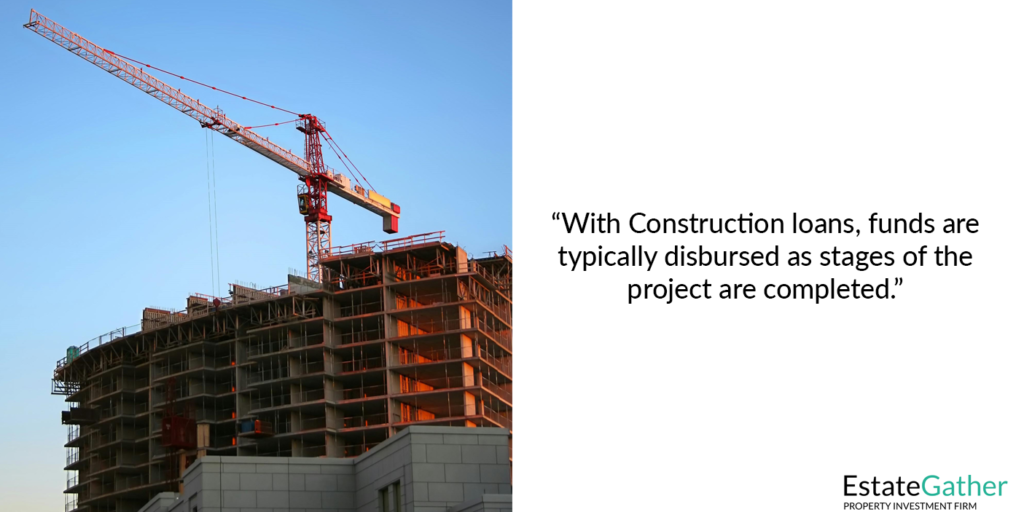
Construction loans are typically short-term, lasting from six months to a year, or until the construction project is completed. The loan is structured to provide periodic disbursements, known as “draws,” which coincide with the completion of different phases of the construction project. This staged disbursement process ensures that funds are available as needed for construction milestones, such as laying the foundation, framing, and finishing work.
One of the main advantages of a construction loan is the flexibility it offers. Borrowers can finance various types of construction projects, including building a new home from scratch, significant home renovations, or adding extensions to an existing property. The loan terms can be tailored to meet the specific needs of the project, providing a customized financing solution.
Interest rates on construction loans are generally higher than those on traditional mortgages due to the increased risk and the short-term nature of the loan. During the construction phase, borrowers typically make interest-only payments on the disbursed amounts. Once construction is complete, the borrower usually needs to convert the construction loan into a permanent mortgage through a process known as “construction-to-permanent” financing. This conversion involves refinancing the construction loan into a traditional mortgage with a longer term and typically lower interest rate.
To qualify for a construction loan, borrowers must meet stringent requirements, including a detailed construction plan, a realistic project timeline, and a comprehensive budget. Lenders will also require a licensed builder or contractor to oversee the project and may request regular inspections to verify progress before releasing funds for each stage of construction. Additionally, borrowers must have a good credit score, stable income, and sufficient funds to cover the down payment and potential cost overruns.
While construction loans offer significant benefits for financing new builds and major renovations, they also come with certain risks and challenges. The approval process can be more complex and time-consuming compared to traditional mortgages, requiring detailed planning and documentation. Borrowers must be prepared for potential delays and cost overruns, which can impact the overall project timeline and budget. Additionally, the higher interest rates and short-term nature of the loan mean that borrowers need to have a clear plan for refinancing or repaying the loan once construction is complete.
Construction loans are best suited for borrowers who have a clear vision for their construction project, a reliable builder or contractor, and a solid financial plan. Working closely with experienced professionals, such as architects, builders, and financial advisors, can help ensure the project’s success and smooth the loan approval process.
Debt Service Coverage Ratio Loans
DSCR loans, short for Debt-Service Coverage Ratio loans, are a type of non-conventional mortgage designed specifically for real estate investors. These loans are unique in that they do not rely on the borrower’s personal income or employment history. Instead, lenders focus on the income-generating ability of the property being financed, evaluating whether it produces enough rent to cover the proposed mortgage payments. This is known as the debt-service coverage ratio.
A DSCR of 1.0 or higher generally means the property brings in enough income to cover its debt obligations. Most lenders require a minimum ratio between 1.0 and 1.25, though some offer more flexibility depending on the loan structure and investor experience.

How It Works
Instead of verifying tax returns, pay stubs, or W-2s, lenders look at the property’s gross rental income, subtract estimated expenses (often using a percentage or actual operating statement), and determine whether the remaining cash flow is sufficient to service the debt. This approach makes DSCR loans especially appealing to:
- Investors with multiple properties
- Borrowers who write off a large portion of their income
- Self-employed individuals or small business owners
- Investors seeking fast, streamlined closings
DSCR loans are typically offered by non-QM (non-qualified mortgage) lenders, credit unions, or private lending institutions. These lenders often hold the loans in their portfolio, giving them more flexibility in underwriting and loan structuring.
Key Features of DSCR Loans
- Qualification Based on Property Cash Flow: Your personal income is not factored in. Approval hinges on the property’s ability to cover the mortgage payment.
- Flexible Documentation: No tax returns, pay stubs, or traditional employment verification required.
- Long-Term Financing: Available as 30-year fixed, adjustable-rate, or interest-only options.
- Scalable Investment Strategy: Makes it easier to qualify for multiple properties simultaneously.
- Available for Refinance or Purchase: Use for new acquisitions, rate-and-term refinances, or cash-out refinances.
Considerations for Borrowers
- Slightly Higher Interest Rates: Rates tend to be higher than conventional mortgages to reflect the added risk.
- Loan-to-Value (LTV) Limits: Typically capped at 75–80% for purchases or refinances.
- Reserve Requirements: Lenders often require 3–12 months of reserves based on the loan amount and portfolio size.
- Minimum DSCR Requirement: Most lenders require a DSCR between 1.0 and 1.25, though some allow exceptions with higher rates or added reserves.
- Property Must Be Rent-Ready or Leased: Lenders expect stabilized properties, and rehab properties may require bridge financing first.
Who DSCR Loans Are Best Suited For
- Real estate investors looking to scale quickly
- Borrowers using the BRRRR strategy (Buy, Rehab, Rent, Refinance, Repeat)
- Individuals with non-traditional income or significant tax write-offs
- Investors who want to avoid full-documentation conventional loans
- Self-employed professionals seeking passive income assets
DSCR loans are most often used to finance 1–4 unit rental properties, though some lenders also offer DSCR-style underwriting for short-term rentals (Airbnb/VRBO), commercial multi-family properties (5+ units), and mixed-use real estate. As long as the property generates income and meets minimum coverage ratios, it can often qualify.
PRO TIP: Use our DSCR Calculator to determine whether your investment property meets the minimum income requirements to qualify for a DSCR loan. Simply input your monthly rental income and projected monthly expenses, and the tool will calculate your coverage ratio automatically.
Private Loans
Private loans are a type of financing provided by non-traditional lenders, such as private individuals, companies, or investment groups, rather than conventional banks or credit unions. These loans can be used for a variety of purposes, including real estate purchases, personal expenses, business ventures, or education costs. Private loans offer flexibility and can be a viable alternative for borrowers who may not qualify for traditional loans due to credit issues, income verification challenges, or other financial constraints.
Private loans are characterized by their flexibility in terms and conditions. Unlike traditional loans, which are typically subject to stringent regulations and standardized criteria, private loans can be tailored to meet the specific needs of the borrower. This customization can include flexible repayment schedules, variable interest rates, and personalized loan amounts. The terms of a private loan are often negotiated directly between the borrower and the lender, allowing for more creative and individualized solutions.
One of the main advantages of private loans is their accessibility. Borrowers who have difficulty obtaining loans from traditional lenders due to poor credit scores, lack of collateral, or irregular income streams may find private loans to be a suitable option. Private lenders are often more willing to take on higher-risk borrowers, focusing more on the potential return on investment and the overall financial picture rather than just credit scores and conventional metrics.
The approval process for private loans is typically faster and less bureaucratic than that of traditional loans. Private lenders can make decisions quickly, often without the need for extensive documentation or lengthy approval procedures. This expedited process can be particularly beneficial for borrowers who need funds quickly or who are engaged in time-sensitive projects, such as real estate transactions or business expansions.
However, private loans often come with higher interest rates and fees compared to traditional loans. The increased cost reflects the higher risk that private lenders assume when providing loans to borrowers who may not meet conventional lending criteria. Additionally, the lack of regulatory oversight means that terms and conditions can vary widely, and borrowers must exercise due diligence to ensure they are entering into a fair and reasonable agreement.
Private loans can be secured or unsecured. Secured private loans require collateral, such as real estate, vehicles, or other valuable assets, which can reduce the lender’s risk and potentially result in more favorable loan terms for the borrower. Unsecured private loans, on the other hand, do not require collateral but typically come with higher interest rates and stricter repayment terms to compensate for the increased risk to the lender.
Borrowers considering private loans should carefully evaluate their financial situation and repayment ability. It is important to thoroughly review the loan agreement, understand all the terms and conditions, and consider the potential impact on their financial future. Consulting with a financial advisor or legal professional can help borrowers navigate the complexities of private loans and ensure they are making informed decisions.
Frequently Asked Questions (FAQ)
What are non-conventional loans?
Non-conventional loans, also known as non-traditional mortgages, offer alternative financing options for borrowers who may not qualify for conventional loans or who have unique financial needs. They include government-backed loans and flexible financing options provided by private lenders.
What types of non-conventional loans are available?
Non-conventional loans include:
- Government Loan Options (FHA, VA, USDA)
- Jumbo Loans
- Portfolio Loans
- Interest-Only Loans
- Balloon Loans
- Bridge Loans
- Hard Money Loans
- Reverse Mortgages
- Home Equity Lines of Credit (HELOCs)
- 203(k) Loans
- Construction Loans
- Private Loans
What are the key benefits of non-conventional loans?
Flexibility in Qualification: Suitable for borrowers with lower credit scores, limited down payments, or unique financial situations.
Government-Backed Options: Loans like FHA, VA, and USDA offer lower interest rates, reduced down payments, and favorable terms.
Specialized Loans: Tailored for specific needs, such as high-value property purchases, short-term investments, or property renovations.
Diverse Funding Sources: Provided by private lenders with customized terms and quicker approval processes.
What are the risks associated with non-conventional loans?
Non-conventional loans often come with higher interest rates and fees due to the increased risk to lenders. Borrowers should be aware of the potential for higher costs and more extensive documentation requirements.
How do non-conventional loans compare to conventional loans?
Loan Limits: Non-conventional loans can exceed limits set by the FHFA.
Interest Rates: Typically higher for non-conventional loans.
Down Payment: May require larger down payments.
Documentation: More extensive for non-conventional loans.
Approval Process: More flexible for non-conventional loans.
Eligibility: Non-conventional loans are accessible to borrowers with unique financial profiles.
Availability: Conventional loans are more common and widely available

